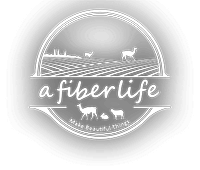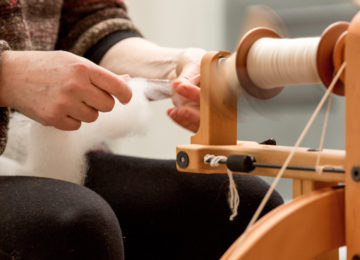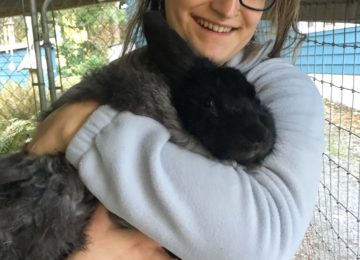Dropped Stitches
Categories:
I learned to knit when I was six
My Grandma Who-Who taught me to knit when I was six. We sat on her bed, propped with bed pillows. She was patient. She cast on some bulky yarn and knit the first few rows for me. I took over the job, knitting back and forth. She helped me flip the heavy metal needles to the right position after I finished each row. I wrapped the yarn around and poked the needle through. I held the needles nearly at nose level and clenched my jaw with effort. My small rectangle grew. When it was long enough to hold her reading glasses, we cast off and sewed the edges together. She tucked that sweet pouch into her purse and used it for years. Needless to say, it had holes. It looked mangled and chewed. Like every new knitter does, I had dropped a number of stitches so there were ladders of yarn where there should be neat v’s side by side. The dropped stitches ran up and down the pouch—panty hose runs beyond repair. But, my grandmother celebrated my knitting. And I was proud.
I wasn’t alone with dropped stitches
There are people who freak out at dropped stitches. They bring their knitting into yarn stores and beg for help. Sometimes they have tears in their eyes. They say things like, “I don’t know what I did, I ruined it, is there anything you can do to save it?” Most of the time, the shop owner can fix the mistake. She gets a crochet hook and pulls the dropped stitch, row by row, up the ladder. And there’s relief and smiles and a pledge of loyalty for the local yarn shop right there on the spot. The dropped stitch disaster is no longer, and that knitter can go on.
The more experienced a knitter you become, the fewer stitches you drop. When and if you do drop a stitch, it’s a fairly easy fix. Sometimes that’s necessary, and sometimes it’s just too cumbersome. I made a grey alpaca sweater last winter and only discovered that I had dropped a stitch in the middle of the back piece when I was sewing the whole sweater together. I wrestled with the choice of whether to rip out half of the back in order to pick up the dropped stitch. I would have had to re-knit the sleeve shaping and the neck shaping—weeks of knitting—way too much work. So I left it—that dangling stitch—right there in the middle of my back. I got a small piece of sewing thread the same color grey and secured it so it wouldn’t run further. It’s hidden now—a dropped stitch not noticed in time, not fixed, not celebrated.
Just the other day I heard a friend confessing that she was wearing a hat she’d knit 9 years ago. It had a dropped stitch in it that had been held in place with a safety pin for all these years. She whipped it off her head and showed me. As if no one would believe she’d done such a ridiculous thing. And Sara, from my spinning group, ended up making her Weekender sweater twice because of a dropped stitch at the neckline that she just couldn’t accept. It’s knit from the top down so the dropped stitch was a mistake in the first couple of inches of her project. She chuckled at herself, “I didn’t mind, the yarn was so lovely, I was happy to have it a bit longer on my needles.”
People can be dropped stitches, too.
I learned on Facebook that my half sister, Katrina, moved from Albuquerque to Santa Barbara. It wasn’t even her post, it was her mother’s. And she hadn’t emailed or called to tell me her new address. It occurred to me that she was a dropped stitch. I’m not sure when it happened, when I stopped keeping track, but she dropped off my radar and left a small hole. I just knit my life around the hole and kept on. Dropped stitches are all over the place if you start to look for them.
There are the dropped stitches of my old professional community. All those creative therapists who brought their wounded healer selves to my studio for inspiration. They’ve moved, I’ve moved. I wish we kept in touch. There’s Sarah, my childhood friend whose hole I can’t quite knit around. Like I keep knitting, but every time I get to that dropped stitch, the one that she left when we stopped talking, I decide to look at the gaping ladder of stitches and leave it, clueless as a new knitter about what to do. Amanda dropped a big stitch. She decided to cut herself off from her toxic mother many years ago. Her dropped stitch is one that is purposeful, part of the pattern, a featured design in a loose knit scarf that leaves a bubble of looser stitches and looks delicate and airy.
Lifelines are the answer
Lace knitters are smart. They have the solution for dropped stitches. It’s literally called a lifeline. A lifeline is a different colored yarn that is threaded into a row so that if the knitter makes a mistake, she only has to rip her work out to the lifeline. If a stitch gets dropped, it will go no further than where the lifeline is placed. It’s a knitters safety harness. When things fall apart, they will only fall a short way and the mess will be contained to those few inches between the lifeline and the needles. It’s really the ultimate assurance for a knitter to use a lifeline. No dropped stitches, no unintentional holes, no unraveling to deal with.
Katrina and I have a lifeline, it’s that summer when she was a toddler and I was her big sister visiting from Pittsburgh, the funnest babysitter ever. It was sweltering hot and her squeals of delight rode the heat waves as I pushed her on the swing set. There are the lifeline moments of gathering around the wood block art table in my studio. The creative mess and painted hands and smiling faces that belonged to the beautiful women who came every month for 10 years. Amanda has lifeline stories. She tells about the mama pig and the baby goats and her mother on the farm. Every time she tells me a story about her mother, it’s as if she checking to see if that lifeline is still there.
We just need to find them
I suppose, if I really feel into it all, knitting is a lifeline for me. When I knit, it takes me back to my grandmother’s bed and her reassuring instruction on how to make one stitch then another, even when it feels hard or you make holes. Like the best of lifelines, knitting is my way back to an innocent time when dropped stitches were no big deal and the pure magic of creating with my own two hands was celebrated.
Keep the connection -to a- fiber life!
Be the first to learn shop updates, new essays, events, and special offers!
Visit-the-Shop
Our animals work year round to grow the most exquisite fibers because we’re the only commercial source of guanaco fiber in the US. Spinners, knitters, and natural fiber wearers, we can’t wait for you to touch the softness.





Oh Lisa,
Your writing delights me. I can picture you as a 6 year old with a new skill. I had a broken leg and could not walk. You came with your mom and visited. I can remembering your tiny body leaned against me working over that knitting. Thanks for the memory.
I love your website, every part of it.
Love,
Wendy
You are the best, my Favorite Aunt Wendy!
Hello Lisa,
your thoughts and words are beautiful, wise and comforting. They really struck a chord with me. Your website is beautiful! I admire your courage to take the leap and start anew on your farm. I´m looking forward to read more of your stories.
I studied creative therapie, but only the foundation year. I found out that I was more into doing art than into therapie. But i like to use art for self exploration. I opened an art studio where I run courses in all kinds of creative media for kids and adults. My aim is to help them get in touch with their innate creativity and to use it as a resource in their life to experience joy and to destress.
I´m working in fiber and textiles, mixed media painting/collage and book arts. My website is in German and gets a total overhaul in the next weeks. But you can see my work and the work of my students on facebook (where I write in German and English) at “Atelier Frei Raum”.
Thank you for the wonderful analogy. I’ve missed your insights.